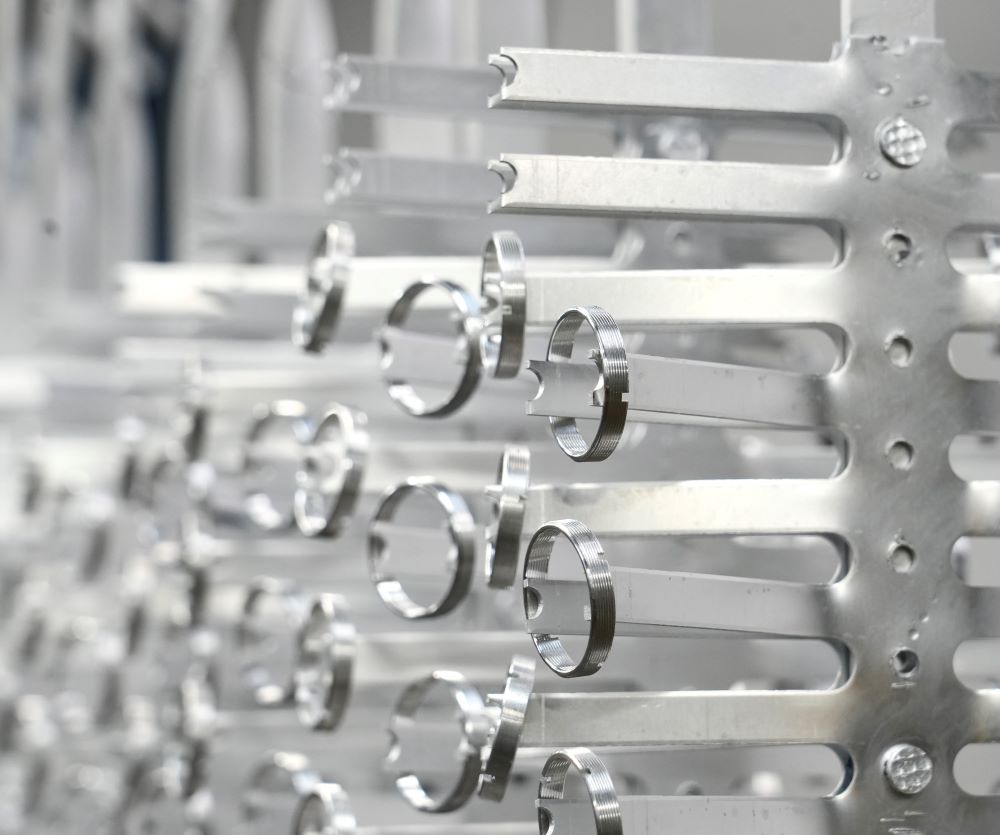
Choosing the Right Rack: A Comparative Guide to Anodizing Rack Types
Here’s an overview for the 5 styles of aluminum anodizing racks—including how they’re used, how parts are attached, and the benefits of each:
V‑Notched Racks
- Usage: V notched racks are ideal for round or disc-shaped components. The V-groove creates a stable cradle that prevents rolling during anodizing. The V Notch also minimizes the contact point for cases where the rack mark size is of importance. V notch racks are also used to hold panels by bending the ends 90 degrees and opposing them at opposite ends of the spline. Another use for V notch racks are parts such as tubes and cups with ID’s large enough to accommodate the V Notches in the ID. For parts like these, the rack marks are contained in the ID typically out of site while offering excellent contact by making 4 contact points Vs two contact points when using pointed of tapered racks.
- Attachment: Panels, round and disc shaped parts sit in the notch, touching only at the two points of the V. Discs are placed so the notch locks them in place, enabling good electrical contact with minimal rack surface exposure. For tubes and cups, the tips of the V notches contact four spots to hold the part securely while providing four points for electrical contact.
- Benefits: V Notched racks simplify loading. Electrical current travels through those precise contact points, making rack marks small and consistent. V Notches can provide more points of contact when they are utilized in the ID of tubes or cups or other parts with holes that can be utilized for racking.
Round‑Notched Racks
- Usage: Round Notch racks are ideal for round or disc-shaped components. The round notch creates a stable cradle that prevents rolling during anodizing. The Round Notch also minimizes the depth and size of contact point for cases where the rack mark size is of importance. Round notch racks accomplish this by distributing the stress applied to the part over a wider surface area and opposes to V notch racks causing for less intrusion into the part. Round notch racks are also used to hold panels by bending the ends 90 degrees and opposing them at opposite ends of the spline. The Round notch rack is suited to holding rods, tubes, or small-diameter cylinders. They should be compared with V notch racks as the geometry of the part being anodized may be better suited to one type of rack o=VS, another.
- Attachment: Components rest against round-tipped fingers or in the notch, holding in place due to slight spring tension in the fingers. The rack’s uniform contact and consistent tension produces uniform anodic coatings. Panels, round parts, and disc shaped parts sit in the notch or on the fingers, touching only at the two points or the base of the round notch. Discs with thinner gage material are placed so the notch locks them in place, enabling good electrical contact with minimal rack surface exposure. Discs with thicker gage material can be secured with the fingers of the notch to provide 4-point contact and uniform coating.
- Benefit: Secure hold without the risk of rolling. The round notch makes it easy to insert and remove parts by hand. The Round Notch rack may prove superior to V notch or other designs based on part geometry. The round notch can also prove superior in holding round parts and discs of thicker gage material on the OD. The rack provides versatility for many geometries.
Square‑Point Racks
- Usage: Square point racks are tailored for panels with lips while also good for flat panels or small plates and pins. Fabrications where the face of the panel is critical are ideal for square tip racks.
- Attachment: The fingers are bent out and the tension of the aluminum holds the panel or fabrication in place from the inside of the panel. Fingers are slightly opened when inserting pins between and again the tension holds the pin in place.
- Benefit: The larger contact area as opposed to a point allows for higher current loads. This can be particularly helpful in Type III (hard coat) anodizing where voltages can reach 70 and beyond. It is also useful when larger loads are desired and the amperage must be increased to maintain the desired current density.
Tapered‑Point Racks
- Usage: These are also referred to as “Utility” racks for their versatility. The tapered point rack works with a variety of shapes including flat parts, discs, tubes or thicker items. They are ideal for automated racking machines, increasing productivity for racking and racking small parts such as nuts and washers. The taper allows for parts of varying IDs to be racked on the same rack simply by sliding it on until the tension of the rack holds the part securely in place.
- Attachment: Tapered fingers hold parts racked through the ID securely in place. J bends to the tips allow racking on a multitude of configurations. Placing the racks on splines parallel to the cathodes can maximize load density while placing them perpendicular to cathodes (or paralell to the tank floor) with 90 bends at the tips can be ideal for securing tubes.
- Benefit: The tapered point is the anodizer’s “utility” rack in that it can take on a large variety of jobs, limited only by the imagination and innovation of the finisher. The tapered rack provides reliable electrical connection while minimizing visible rack marks, especially when concealed in the ID of the part.
Large‑Point Racks
- Usage: Large point racks have two main and very contrasting uses. The large point racks are used for heavy-duty applications—large castings, thick plates, or big tooling where the part must be secure, receiving good amperage and minimizing the potential for burning yet minimizing the number of contact points. The sharp point of the large point rack by contrast makes it the go to rack for very small ID parts as the tip can be inserted into tiny IDs. This coupled with the robust size and spring tension of the fingers themselves make it a workhorse for automatic rack machines when very tiny ID parts are being anodized.
- Attachment: Thicker fingers with greater tension than most other aluminum configurations hold firmly onto parts. The sharp points are usually spaced wide enough to create enough tension to hold the part from the id. The sharp points also leave almost undetectable rack marks depending on the application.
- Benefit: Excellent current-carrying capability and gripping power. When used to secure larger and heavier parts, they may leave more visible rack marks but this is necessary for demanding tasks. In Contrast, the sharp points are ideal for the smallest of IDs in anodizing small parts leaving nearly undetectable rack marks while holds parts firmly.

